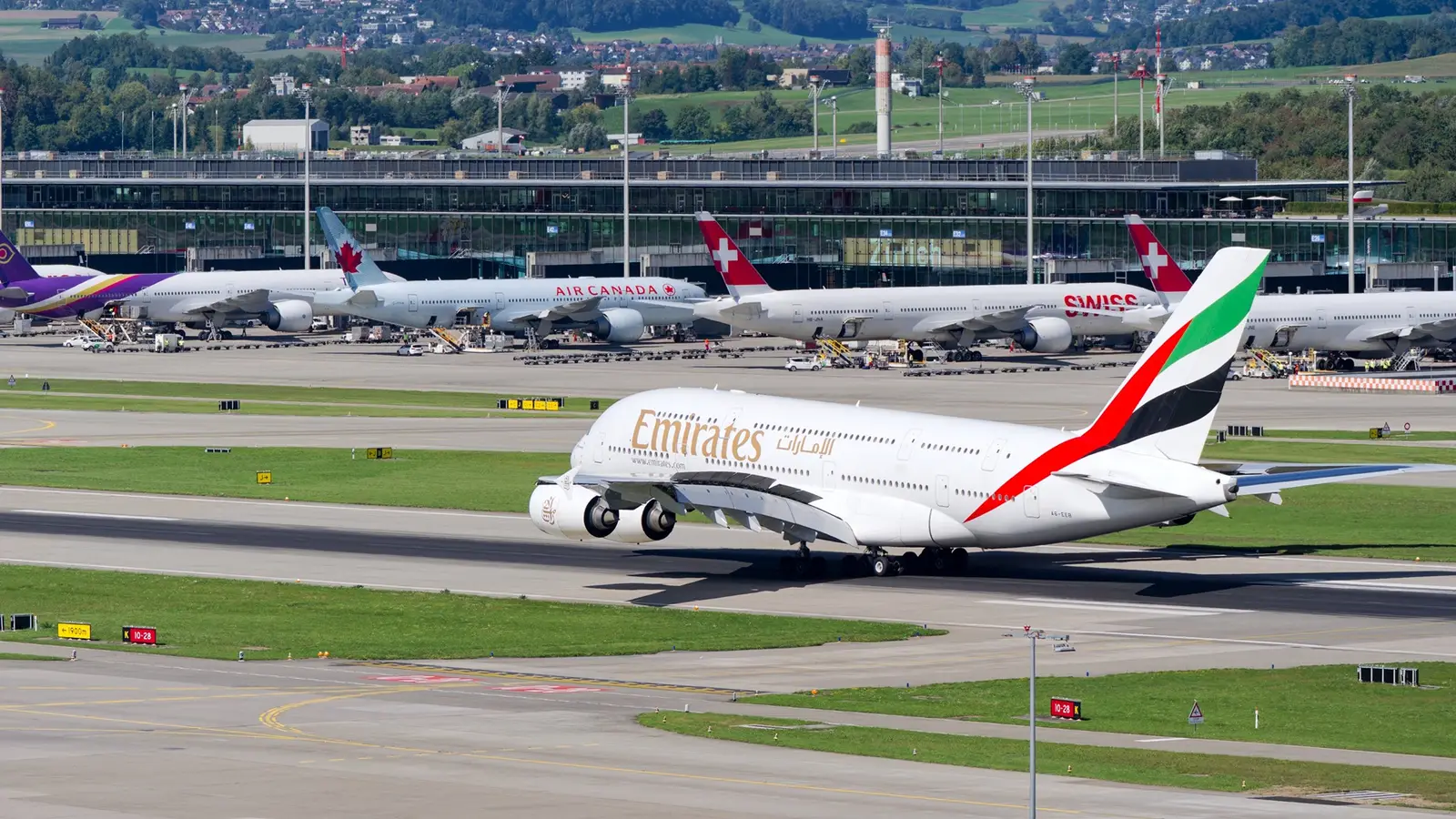
We are going down the list of the top five destinations on the super jumbo flight itinerary. In this flight route review, you will find the highest traffic Airbus A380 hubs by flight numbers in 2025. As the global leader in A380 fleet size, Emirates is the top choice for any flyer looking to catch a ride on the biggest airliner ever made. In the ranking provided by Cirium.com data, Dubai International Airport (DBX) is on one end of every single roster entry.
The colossal A380 remains the largest jetliner ever to be constructed, and with the assembly line shut down in 2021 and no successor apparent, that fact is likely to remain the case for many years to come. As the commercial aircraft market has shifted heavily in favor of twinjets like the Airbus A350 and Boeing 777X, the final days of the super jumbo may well be upon us.
Emirates continues to keep the incredible machine in the air, with half of the total ever made in its inventory. The carrier snatches up secondhand jets whenever it can and has pushed Airbus for a new A380neo, but these efforts have only slowed the fleet’s decline. If you are a fan and have the chance to jump on a ride from one of the destinations on the list below, you may want to take your opportunity before the clock runs out on Airbus’ giant of the skies.
5 Paris To Dubai
1,098 Flights In 2025
One of Emirates’ most popular routes is Dubai to Paris.The airline utilizes its Airbus A380s to maximize the value of the high-value slots at both hubs. French tourists and shoppers flock to Dubai’s tax-free malls and winter sun, while business executives enjoy the luxurious cabins as they travel to the United Arab Emirates. The aircraft itself is an exceptional branding tool with quiet rooms, onboard lounges, and showers. All of that bolsters Emirates’ premium image in the competitive Paris market.
Emirates needs to increase capacity per departure due to slot caps. Multiple daily A380s have moved over half a million seats this year: 565,024 to be exact. On top of local origin flyers, connecting traffic is a major factor at Paris Charles De Gaulle Airport (CDG) to destinations like India, Sri Lanka, the Maldives, Southeast Asia, Australia, and East Africa. By passing through Emirates’ hub, you can skip making several shorter point-to-point flights.
CDG’s peak periods are already slot-squeezed, and using one double-decker rather than two twins saves valuable windows. The two airports are a modest 3,259 miles apart, but demand justifies the monstrous plane. The cavernous bottom deck of the A380 also attracts a lot of cargo traffic, particularly luxury products and special items on top of regular baggage.
4 Dubai To Manchester
1,098 Flights In 2025
Emirates has assigned the Airbus A380 to all three of its daily flights serving the Manchester Airport (MAN) to Dubai artery. It has quietly emerged as one of its most popular routes. Although there are about 20 million people living in Northern England and Wales, Heathrow (LHR) controls the majority of intercontinental travel. Employing a 517-seat A380, Emirates can channel demand through its Dubai (DXB) hub without more slots at Heathrow.
The route has transported 628,883 flyers over the 3,518-mile route this year. Premium accommodations offer the best travel experience for football fans, trade show attendees, and other flyers. The geographical crossroads at DXB also offers a launching point for tourists headed to more distant corners of the world or those headed to see extended family in the Indo-Pacific, Australia, and other far-flung destinations.
The same payload carried by a single A380 would require two smaller widebodies. It uses less fuel per seat, saves crew expenses, and frees up scarce slots on DXB’s congested runway, offering a staggering 2.2 million seat miles. Manchester even made an investment in a specially designed A380 pier, guaranteeing efficient turnarounds.
3 Sydney To Dubai
1,098 Flights In 2025
The longest entry on this list is the Dubai to Sydney route at 7,480 miles. Every day, Emirates operates multiple enormous Airbus A380s to and from Sydney Kingsford Smith Airport (SYD), which has generated nearly 4 million seat miles in traffic this year. The giant jet satisfies three major requirements simultaneously: demand, airport constraints, and distance. Sydney is a major global hub for air travelers, just like Dubai, and the most important airport in the Oceania region of the world.
A 500-seat double-decker keeps costs competitive and nearly always sells out thanks to a combination of convenience and exceptional service options. Due to a government noise curfew, it runs at maximum capacity during the day and cuts back on operations at night. The gigantic airplane helps Emirates get as many flyers in and out during the regular hours as possible. The aircraft itself is tailor-made for the 14-hour journey. A full cabin, checked baggage, and tons of freight are easily hauled by four immense engines to Dubai nonstop.
The economics are unexpectedly good because the costs are offset by a large number of passengers. The quieter cabins, broader seats, and larger overhead bins make everyone happy. For luxury ticket holders, inflight lounges and even showers are some of the one-of-a-kind features. With high-value cargo like electronics, pharmaceuticals and even fresh Australian meat, the cargo side of the business helps the bottom line too.
2 Dubai To Bangkok
1,417 Flights In 2025
Bangkok is one of the world’s most visited cities, drawing holiday travelers from Europe, Africa, and the Middle East every week of the year, not just during peak season. Add thousands of Thai citizens working in the Gulf who shuttle home on their leave with business flyers, and seat occupancy rarely dips. Many of the 790,956 passengers who have taken this route in 2025 are actually connecting onward beyond Dubai, so every full A380 feeds profit across the wider Emirates network.
Neither end of the route can simply absorb extra departures whenever an airline feels like adding them. Dubai International already runs close to its limit in terms of slot availability, while Bangkok Suvarnabhumi Airport(BKK) is equally busy on top of ongoing renovations. When the number of daily takeoff and landing slots is finite, the most sensible way to capture growing traffic is to use the biggest aircraft available. Replacing a 360-seat Boeing 777 with a 517-seat A380 adds the capacity of an entire narrowbody flight without needing an extra slot, extra crew rotation, or extra gate.
The flight time of six to seven hours over the 3,050-mile span is long enough for travelers to appreciate the A380’s quieter cabin, wider seats, and onboard lounge. It is also short enough that the aircraft can make a second trip within the same 24-hour cycle, multiplying its earning power. Constant demand, limited slots, and efficient use of a very large aircraft together offer a clear explanation as to why the giant appears so often on this vital artery of air travel.
1 London Heathrow To Dubai
2,196 Flights In 2025
London and Dubai represent opposite sides of one of the busiest airbridges in the aviation world. On one side is Emirates’ home base, while London Heathrow Airport (LHR) is the United Kingdom’s most popular entry point and an airport with a full runway schedule from sunrise to sunset. The A380 is clearly the workhorse for the job on a route that has ferried over 1 million flyers this year (in terms of raw seat availability). The 3,420-mile jaunt is taken easily in stride by the A380’s enormous range and performance figures.
Each precious Heathrow slot produces more revenue with an A380 taking off than it does with a 777 or A350. It also spares the airline the impossible task of finding extra slots. With the largest fleet of A380s in the world, Emirates depends on the aircraft to deliver consistently, and it does. Seats are quickly filled thanks to high demand on the route. Each city is a world center of finance, business, and trade, with expatriates from both nations living in the cities that host these mega-hubs.
Emirates is reinvesting in its fleet of colossal commercial jets with a $2 billion fleet overhaul, with the first renovated example being delivered just weeks ago. Business Traveller reports that the jets received a lighter color scheme in First Class and Business Class cabins and more of the popular Premium Economy seats. The A380’s cabins received new carpets and wall panels, with cream-colored leather upholstery and light wood finishes in the First and Business Cabins.
Infrastructure seals the deal, as Dubai constructed a whole concourse around the A380, while the terminals at Heathrow have wide enough taxiways to serve the flying giant at multiple gates. Despite the relatively short distance compared to the Sydney route, the extremely high number of flights has generated nearly 4 million available seat miles in 2025. As Heathrow looks to add a third runway and Emirates is striving to keep its A380 fleet in the air until their airframes age out, It’s safe to bet this route will remain top of the charts for years to come.



